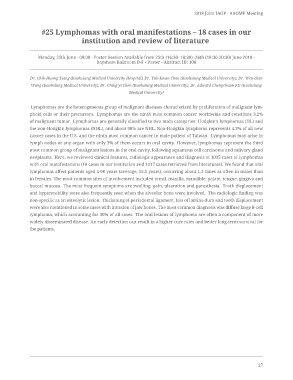Page 53 - AAOMP Onsite Booklet
P. 53
2018 Joint IAOP - AAOMP Meeting
#25 Lymphomas with oral manifestations – 18 cases in our
institution and review of literature
Monday, 25th June - 00:00 - Poster Session Available from 25th (16:30- 18:30) -26th (18:30-20:30) June 2018 -
Bayshore Ballroom D-F - Poster - Abstract ID: 108
Dr. Chih-Huang Tseng (Kaohsiung Medical University Hospital), Dr. Yuk-Kwan Chen (Kaohsiung Medical University), Dr. Wen-chen
Wang (Kaohsiung Medical University), Dr. Ching-yi Chen (Kaohsiung Medical University), Dr. Edward Chengchuan KO (Kaohsiung
Medical University)
Lymphomas are the heterogeneous group of malignant diseases characterized by proliferation of malignant lym-
phoid cells or their precursors. Lymphomas are the ninth most common cancer worldwide and constitute 3.2%
of malignant tumor. Lymphomas are generally classified to two main categories: Hodgkin’s lymphomas (HL) and
the non-Hodgkin lymphomas (NHL), and about 90% are NHL. Non-Hodgkin lymphoma represents 4.3% of all new
cancer cases in the U.S. and the ninth most common cancer in male patient of Taiwan. Lymphomas may arise in
lymph nodes or any organ with only 3% of them occurs in oral cavity. However, lymphomas represent the third
most common group of malignant lesions in the oral cavity, following squamous cell carcinoma and salivary gland
neoplasms. Here, we reviewed clinical features, radiologic appearance and diagnosis of 1035 cases of lymphomas
with oral manifestations (18 cases in our institution and 1017 cases retrieved from literatures). We found that oral
lymphomas affect patients aged 4-96 years (average, 55.1 years), occurring about 1.3 times as often in males than
in females. The most common sites of involvement included tonsil, maxilla, mandible, palate, tongue, gingiva and
buccal mucosa. The most frequent symptoms are swelling, pain, ulceration and paresthesia. Tooth displacement
and hypermobility were also frequently seen when the alveolar bone were involved. The radiologic finding was
non-specific as an osteolytic lesion. Thickening of periodontal ligament, loss of lamina dura and tooth displacement
were also mentioned in some cases with invasion of jaw bones. The most common diagnosis was diffuse large B-cell
lymphoma, which accounting for 30% of all cases. The oral lesions of lymphoma are often a component of more
widely disseminated disease. An early detection can result in a higher cure rates and better long-term survival for
the patients.
27

